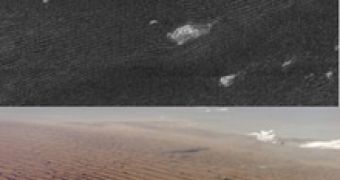Cassini radar images show sand dunes 100 meters high on Saturn's giant moon Titan. The dunes run parallel to each other for hundreds of kilometers at Titan's equator. One dune field is more than 1500 km long, said Ralph Lorenz of Lunar and Planetary Laboratory from the University of Arizona.
"It's bizarre," Lorenz said. "These images from a moon of Saturn look just like radar images of Namibia or Arabia. Titan's atmosphere is thicker than Earth's, its gravity is lower, its sand is certainly different -- everything is different except for the physical process that forms the dunes and resulting landscape."
Until a couple of years ago, scientists thought the dark equatorial regions of Titan might be liquid ethane oceans. But the new radar evidence shows they are seas - but seas of sand. Ten years ago, scientists believed that Saturn's moon Titan is too far from the sun to have solar-driven surface winds powerful enough to sculpt sand dunes.
But researchers have since learned that Saturn's powerful gravity creates significant tides in Titan's atmosphere. Saturn's tidal effect on Titan is roughly 400 times greater than our moon's tidal pull on Earth.
As first seen in circulation models a couple of years ago, Lorenz said, "Tides apparently dominate the near-surface winds because they're so strong throughout the atmosphere, top to bottom. Solar-driven winds are strong only high up."
The dunes seen by Cassini radar have the characteristics of dunes formed by winds blowing from different directions. According to Lorenz, the tides cause wind to change direction as they drive winds toward the equator.
"When we saw these dunes in radar it started to make sense," he said. "If you look at the dunes, you see tidal winds might be blowing sand around the moon several times and working it into dunes at the equator. It's possible that tidal winds are carrying dark sediments from higher latitudes to the equator, forming Titan's dark belt."
How the sand formed?
The composition of the sand grains (are they made of organic solids, water ice, or a mixture of both?) is a mystery. Cassini's Visual and Infrared Mapping Spectrometer, led by UA's Robert Brown, may get results on sand dune composition.
Scientists think that the sand may have formed when liquid methane rain eroded particles from ice bedrock. Observations and models of Titan show that clouds and rain are rare but when it rains on Titan, it rains in very energetic events, just as it does in the Arizona desert, Lorenz said. Energetic rain that triggers flash floods may be a mechanism for making sand, he added.
An alternative is that the sand may come from organic solids produced by photochemical reactions in Titan's atmosphere.
"It's exciting that the radar, which is mainly to study the surface of Titan, is telling us so much about how winds on Titan work," Lorenz said. "This will be important information for when we return to Titan in the future, perhaps with a balloon."
Photo credits: NASA/JPL

 14 DAY TRIAL //
14 DAY TRIAL // 
